Portions
of this page have been extracted verbatim from the webpage "NOVA Online
| Super Bridge | Arch Bridges." http://www.pbs.org/wgbh/nova/bridge/meetarch.html
(08/28/01 23:03:25)
Arch
Bridge
|
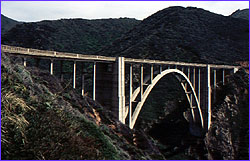 Arch Bridge
Arch Bridge
Bixby Creek Bridge, Monterey, CA
|
Arch bridges are one of the oldest types of bridges and have great natural strength.
Instead of pushing straight down, the weight of an arch bridge is carried outward
along the curve of the arch to the supports at each end. These supports, called
the abutments, carry the load and keep the ends of the bridge from spreading
out.
Try It!
How do the abutments support an arch bridge?
 Cut a strip of cardboard that's about one inch by 11 inches. Gently bend the
strip so that it has a curve. Position the cardboard on a table so that it
resembles an arch. Press down on the center of the arch. What happens to the
ends of the cardboard?
Cut a strip of cardboard that's about one inch by 11 inches. Gently bend the
strip so that it has a curve. Position the cardboard on a table so that it
resembles an arch. Press down on the center of the arch. What happens to the
ends of the cardboard?
 Next, place a stack of books at each end of the arch. Press again. Now what
happens? Notice how the stacks of books act as abutments, keeping the ends
of the arch from spreading apart.
Next, place a stack of books at each end of the arch. Press again. Now what
happens? Notice how the stacks of books act as abutments, keeping the ends
of the arch from spreading apart.
When supporting its own weight and the weight of crossing traffic, every
part of the arch is under compression. For this reason, arch bridges must
be made of materials that are strong under compression.
|
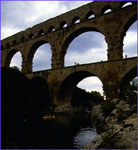 The Pont du Gard aqueduct
The Pont du Gard aqueduct
|
The Romans used stones. One of the most famous examples of their handiwork is
the Pont du Gard aqueduct near NÓmes, France. Built before the birth of Christ,
the bridge is held together by mortar only in its top tier; the stones in the
rest of the structure stay together by the sheer force of their own weight.
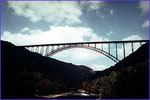 The New River bridge
The New River bridge
|
|
Today materials like steel and pre-stressed concrete have made it possible to
build longer and more elegant arches, including a spectacular 1700 foot span
in New River Gorge, West Virginia. (More typically, modern arch bridges span
between 200-800 feet.)
|
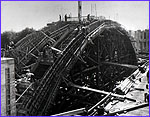 Centering under construction
Centering under construction
|
Constructing an arch bridge can be tricky, since the structure is completely
unstable until the two spans meet in the middle. One technique is to build elaborate
scaffolding, or "centering," below the spans to support them until they meet.
A newer method supports the spans using cables anchored to the
|
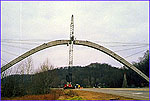 Arch construction using
cable supports
Arch construction using
cable supports
|
|
ground on either side of the bridge. In situations where there is an active
water or road way below, this method allows contractors to build without disrupting
traffic.
|
 The Natchez Trace bridge
The Natchez Trace bridge
|
One of the most revolutionary arch bridges in recent years is the Natchez Trace
Bridge in Franklin, Tennessee, which was opened to traffic in 1994. It's the
first American arch bridge to be constructed from segments of pre-cast concrete,
a highly economical material. Two graceful arches support the roadway above.
Usually arch bridges employ vertical supports called "spandrels" to distribute
the weight of the roadway to the arch below, but the Natchez Trace Bridge was
designed without spandrels to create a more open and aesthetically pleasing
appearance. As a result, most of the
live load is resting on the crowns
of the two arches, which have been slightly flattened to better carry it. Already
the winner of many awards, the bridge is expected to influence bridge design
for years to come.
Cut a strip of cardboard that's about one inch by 11 inches. Gently bend the
strip so that it has a curve. Position the cardboard on a table so that it
resembles an arch. Press down on the center of the arch. What happens to the
ends of the cardboard?
Next, place a stack of books at each end of the arch. Press again. Now what
happens? Notice how the stacks of books act as abutments, keeping the ends
of the arch from spreading apart.